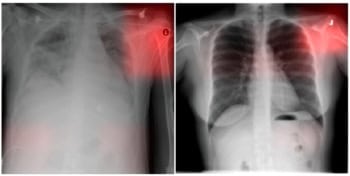
Raman spectroscopy could ease the diagnosis of thyroid cancer, according to a study from researchers at UC Davis and the University of Washington. The label-free spectroscopic technique, which uses inelastic scattering of light to identify a sample’s molecular composition, can distinguish between benign and cancerous human thyroid cells with 97% accuracy (Biomed. Opt. Express 10.1364/BOE.10.004411).
Thyroid cancer is the ninth most common cancer, with more than 50,000 new cases diagnosed in the US each year. One common symptom is a lump in the neck – although most thyroid nodules aren’t cancerous. Suspicious nodules are typically analysed using ultrasound-guided fine needle aspiration, in which cells removed from the nodule are stained and analysed by a pathologist.
In roughly 15–30% of cases, however, the pathologist cannot determine whether the biopsied cells are benign or malignant, and a thyroidectomy is required to surgically remove tissue. A technique that could more accurately diagnose and differentiate thyroid nodules would avoid unnecessary surgeries and have a major impact on patient care and management.
With this aim, the research team investigated Raman spectroscopy as a possible diagnostic alternative. The technique identifies intrinsic molecules in cells and tissues without requiring sample preparation or staining, can offer subcellular spatial resolution if implemented into a confocal microscope and is non-destructive.
“We would like to use Raman spectroscopy to improve the pathologist’s analysis of the cells obtained with fine needle aspiration to reduce the number of thyroidectomies necessary,” explains James Chan from UC Davis. “This would both minimize surgical complications and reduce healthcare costs.”
For their study, the researchers used a line-scan Raman microscope to rapidly acquire Raman signals from an entire cell volume. They recorded a total of 248 Raman images of individual cells isolated from 10 patient thyroid nodules diagnosed as benign (n=127) or cancerous (n=121).

To convert the hyperspectral Raman image of a cell into a single Raman spectrum representing its overall chemical composition, the researchers summed the spectral signals from all cell pixels in the image. They used these single-cell spectra in all subsequent analysis for classifying cell type. They note that this method more accurately captures the composition of the entire cell compared with other approaches that acquire a Raman spectrum from only part of a cell’s volume.
The researchers then used multivariate statistical methods, principal component analysis and linear discriminant analysis to analyse the Raman data and classify the cells based on their Raman spectral signatures. The data analysis identified unique spectral differences – attributed to phenylalanine, tryptophan, proteins, lipids and nucleic acids – that could distinguish cancerous from benign cells with 97% diagnostic accuracy. The team also demonstrated that other cell subtypes could be identified by their spectral differences.
“Our encouraging results show that Raman spectroscopy could be developed into a new optical modality that can help avoid invasive procedures used to diagnose thyroid cancer by providing biochemical information that isn’t currently accessible,” says Chan. “This could have a major impact in the field of pathology and could lead to new ways to diagnose other diseases.”
To confirm the accuracy of the Raman technique, the team plan to test it on more cells and patients. They also need to apply the approach to cells obtained via fine needle aspiration and samples with indeterminate cytology. Finally, the researchers hope to develop an automated prototype system that can perform the Raman measurements and analysis with minimal human intervention.
“These preliminary results are exciting because they involve single cells from human clinical samples, but more work will need to be done to take this from a research project to final clinical use,” notes Chan.



